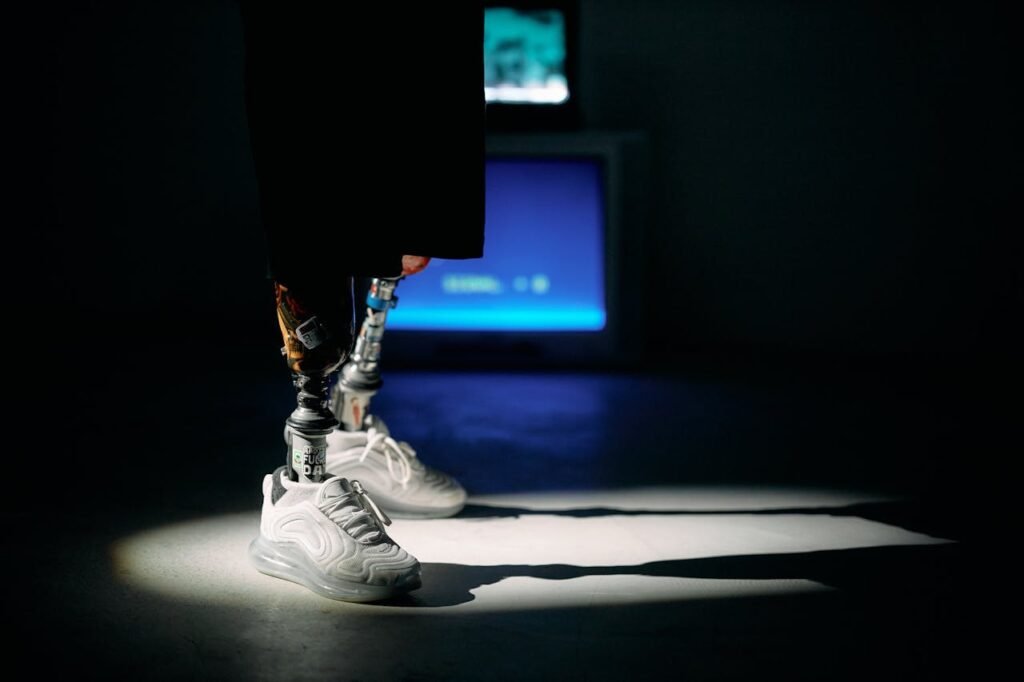Every step should feel secure. For seniors using prosthetic limbs, the right footwear is not just about comfort—it’s about safety, balance, and confidence. A shoe that grips the ground properly, supports the foot evenly, and fits well can turn uncertain steps into steady ones.
Footwear might seem like a small detail, but it makes a huge difference in daily life. The right pair protects your joints, improves your walking pattern, and keeps you from slipping. The wrong one can cause imbalance, pain, or even dangerous falls.
At RoboBionics, we’ve seen how much smoother walking becomes when seniors pair their prosthetics with shoes designed for their needs. This guide will walk you through everything you need to know—how to choose, wear, and care for safe, slip-resistant footwear that keeps you moving comfortably.
Why Footwear Matters for Seniors with Prosthetics
The Foundation of Stability
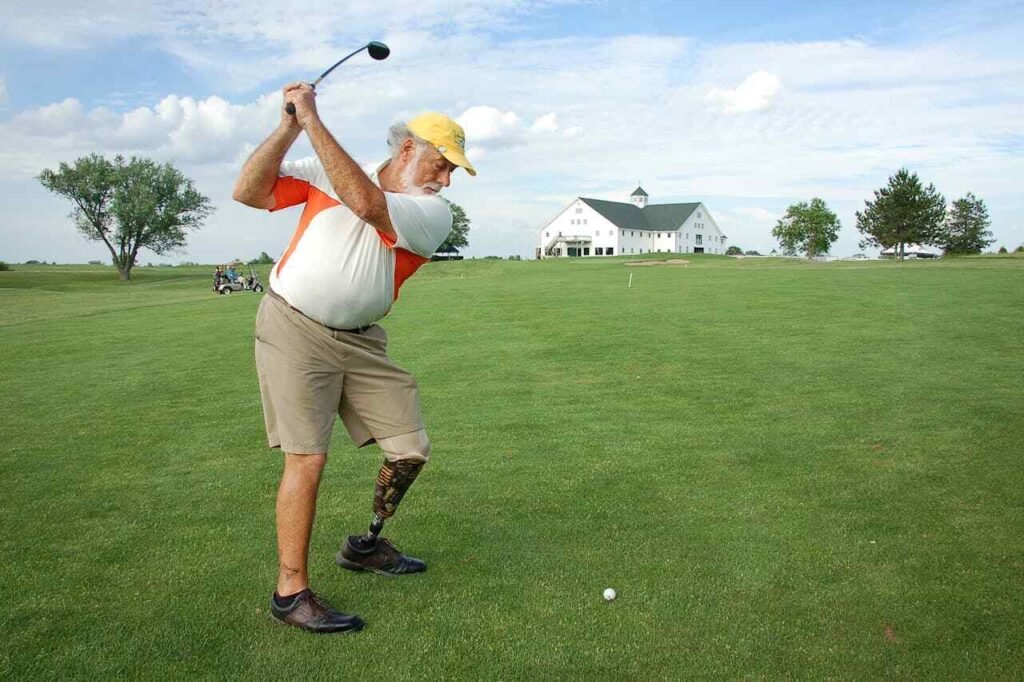
Your shoes form the base of every step you take. For seniors using prosthetic limbs, this base determines how steady, smooth, and comfortable walking feels.
When footwear supports your prosthesis correctly, it aligns your hips, knees, and spine. This reduces fatigue, prevents strain, and allows your body to move naturally.
Even a small change in heel height or sole thickness can affect your balance. That’s why selecting the right shoes isn’t just about appearance—it’s about function and safety.
The Role of Footwear in Prosthetic Balance
Every prosthetic limb is designed with balance in mind, but that balance depends on the surface beneath it. A stable, slip-resistant sole ensures your prosthesis grips the ground evenly.
If a shoe is too soft or unstable, it may cause your prosthesis to tilt slightly, forcing your body to work harder to stay upright. Over time, that can lead to joint pain or poor posture.
Proper footwear keeps your body aligned, reduces energy loss, and makes every step smoother and more confident.
Comfort Beyond Cushioning
Comfort in prosthetic footwear goes beyond soft padding. It’s about fit, support, and how the shoe interacts with your prosthesis and your natural limb.
A good shoe evenly distributes pressure, minimizing friction on your residual limb. It also prevents shifting inside the socket, which can cause rubbing or irritation.
When comfort and balance work together, walking feels effortless—and that’s exactly what the right footwear provides.
Understanding Footwear and Prosthetic Interaction
Matching the Shoe to the Prosthesis
Not every prosthetic limb is suited to every shoe. The shape, height, and stiffness of your shoe’s sole affect how your prosthesis performs.
For instance, if your prosthetic foot is set to a specific heel height, wearing shoes with higher or lower heels can throw off your alignment. This can make walking uneven or even unsafe.
Your prosthetist can tell you the ideal heel height for your prosthesis. Sticking close to that measurement ensures your gait remains smooth and balanced.
Equal Weight Distribution
Shoes should help you distribute your weight evenly across both sides of your body. Uneven footwear can cause limping or overuse of your sound leg.
A shoe with a firm midsole and structured heel keeps pressure balanced, allowing your prosthetic side to share the load naturally.
Even small differences—like a worn-out sole or a compressed heel—can affect how your body carries weight. Regularly checking your shoes for wear helps maintain balance and safety.
The Importance of Proper Fit
A shoe that’s too loose may cause your prosthesis to shift. One that’s too tight can lead to swelling or restricted movement.
Fit should feel snug but never constrictive. Your heel should stay in place, your toes should have room to move, and your foot should rest comfortably on the insole.
For seniors, slight swelling throughout the day is common. Choosing shoes with adjustable closures—like Velcro or elastic laces—helps you adapt easily without discomfort.
The Impact of Surface Grip
Slip-resistant soles are especially important for seniors. They prevent falls on smooth or wet surfaces and give your prosthesis better traction.
A well-designed sole grips without being sticky. It should offer enough flexibility to move naturally but still keep firm contact with the ground.
Textured rubber outsoles with tread patterns work best for indoor and outdoor use. They provide consistent traction and reduce the risk of sudden slips.
Characteristics of Senior-Safe Prosthetic Footwear
Firm Heel Support
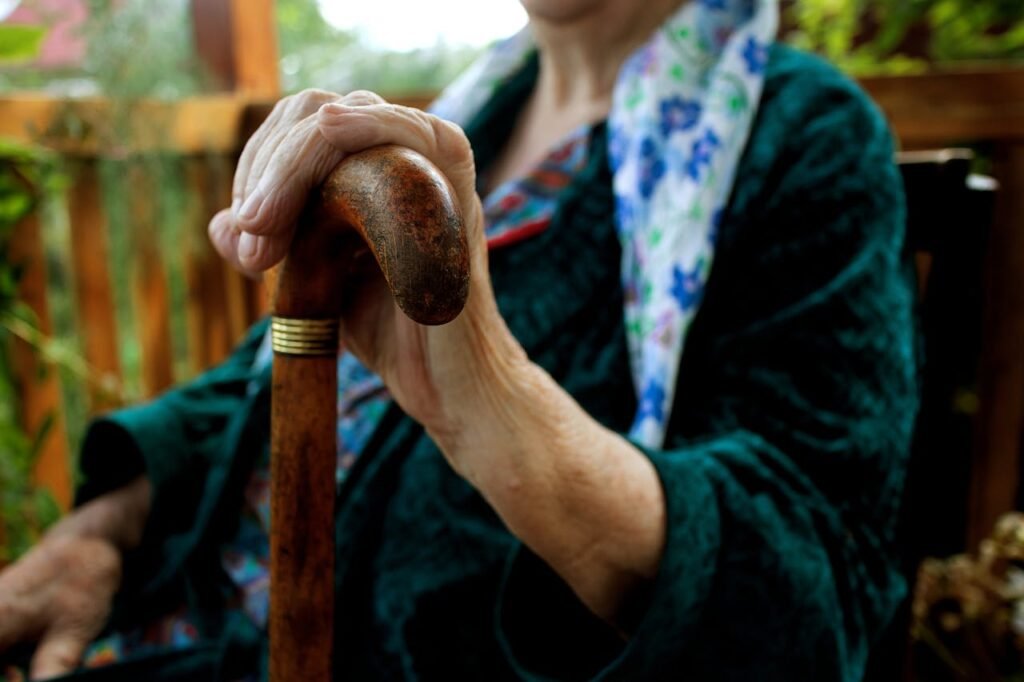
A firm heel counter—the back part of the shoe that cups your heel—provides essential stability. It keeps your prosthetic and natural foot aligned and prevents wobbling.
Without proper heel support, your prosthetic foot may roll outward or inward during steps, increasing the risk of falls.
Firm heel construction also improves energy transfer when walking, making each stride feel easier and more efficient.
Low, Stable Heel Height
High heels or shoes with uneven soles shift your body weight forward, throwing off your balance. For prosthetic users, even small heel differences can cause discomfort.
The ideal heel height for most prosthetic limbs is around one inch or less. This provides a flat, steady platform while maintaining a natural gait.
Low, wide heels also give better contact with the ground, increasing security with each step.
Soft, Non-Slip Soles
A sole should be flexible enough to allow smooth motion but sturdy enough to provide grip. Rubber or synthetic soles with textured patterns offer great traction on both indoor and outdoor surfaces.
Avoid shoes with hard leather or smooth bottoms—they can slide easily on tiles or polished floors.
If you walk mostly indoors, look for shoes that won’t leave marks but still offer slip resistance. Balance between comfort and safety is the goal.
Lightweight Construction
Heavy shoes make walking tiring, especially for seniors with prosthetics. Lightweight materials reduce strain on your joints and make movement feel effortless.
Modern walking shoes and adaptive footwear use breathable fabrics and cushioned midsoles without extra weight.
Lightweight shoes also make it easier to lift and swing your prosthetic leg naturally during steps.
Easy Fastening Options
Many seniors find bending down or tying shoelaces difficult. Shoes with easy closures—like Velcro straps, elastic laces, or zip-up sides—simplify daily use.
These closures also allow for quick adjustments throughout the day as your feet or residual limb change slightly in size.
Convenience shouldn’t mean compromise. Easy closures can still provide firm, reliable support when designed well.
Choosing the Right Type of Footwear
Everyday Walking Shoes
For daily wear, choose shoes designed for consistent use—lightweight, breathable, and supportive. Look for pairs with cushioned insoles and flexible soles that adapt to your walking motion.
A rounded or rocker-style sole can help mimic natural movement, especially if your prosthetic ankle doesn’t flex.
Make sure the inner lining is smooth and seam-free to prevent rubbing or blisters.
Home and Indoor Footwear
At home, comfort and grip matter most. Soft, slip-on shoes or cushioned slippers with anti-slip soles are ideal. Avoid socks alone—they don’t provide enough traction.
Your indoor shoes should fit snugly and provide light support to prevent fatigue. Even at home, stable footwear reduces fall risk and encourages steady movement.
Outdoor and Walking Shoes
When you step outside, surfaces can change quickly—from smooth pavements to rough paths. Choose outdoor shoes with durable soles, water resistance, and extra grip.
Trail walking or comfort sneakers designed for seniors often combine traction, cushioning, and balance support in one package.
Make sure they’re easy to clean—dust and moisture buildup can make soles slippery over time.
Dress or Formal Footwear
Special occasions call for style, but never at the cost of comfort. Many modern formal shoes come with orthopedic insoles and flexible soles that still look elegant.
Stick to lower heels and choose models with wide toe boxes to avoid pressure. Some brands even design adaptive footwear that blends professional appearance with prosthetic-friendly support.
Adaptive and Medical Shoes
Adaptive shoes are designed for those with unique foot shapes, prosthetic needs, or sensitive skin. They often have wider openings, removable insoles, and adjustable depth.
For seniors with prosthetic limbs, these shoes can make wearing and removing footwear much easier. They also accommodate swelling or braces without pressure.
Consult your prosthetist or orthotist before purchasing medical-grade shoes to ensure proper alignment and comfort.
Testing Shoes Before You Buy
Try Both Sides
Always try both shoes on—your prosthetic side and your natural side. Walk around slowly and notice how balanced you feel.
If one side feels higher, heavier, or uneven, try adjusting the insole or thickness of your sock. Even small mismatches can make walking tiring.
Testing in-store or at home (if buying online) ensures your shoes match your prosthesis perfectly before you commit.
Walk on Different Surfaces
If possible, test your shoes on more than one surface—carpet, tile, and concrete. Each reacts differently with your prosthetic sole.
Good footwear should grip steadily on all three. If you feel slipping or wobbling on smooth floors, the tread may not be right for you.
Choose shoes that feel safe across surfaces where you spend most of your time.
Focus on Comfort, Not Just Fit
A shoe might technically fit but still feel wrong after a few steps. Comfort should always come first.
Notice any pressure, rubbing, or tightness around your toes, heel, or prosthetic socket. These early signs of discomfort often worsen with longer wear.
Your shoes should feel like an extension of your prosthesis—not an obstacle.
Take Your Prosthesis Along
When buying shoes, always bring your prosthesis with you. Trying on footwear without it won’t give a realistic sense of balance or alignment.
Your prosthetist can also help you test shoes to ensure heel height and sole stiffness match your limb’s setup.
This step saves time, prevents future pain, and guarantees proper function right from the start.
Materials That Make a Difference
Upper Materials and Breathability
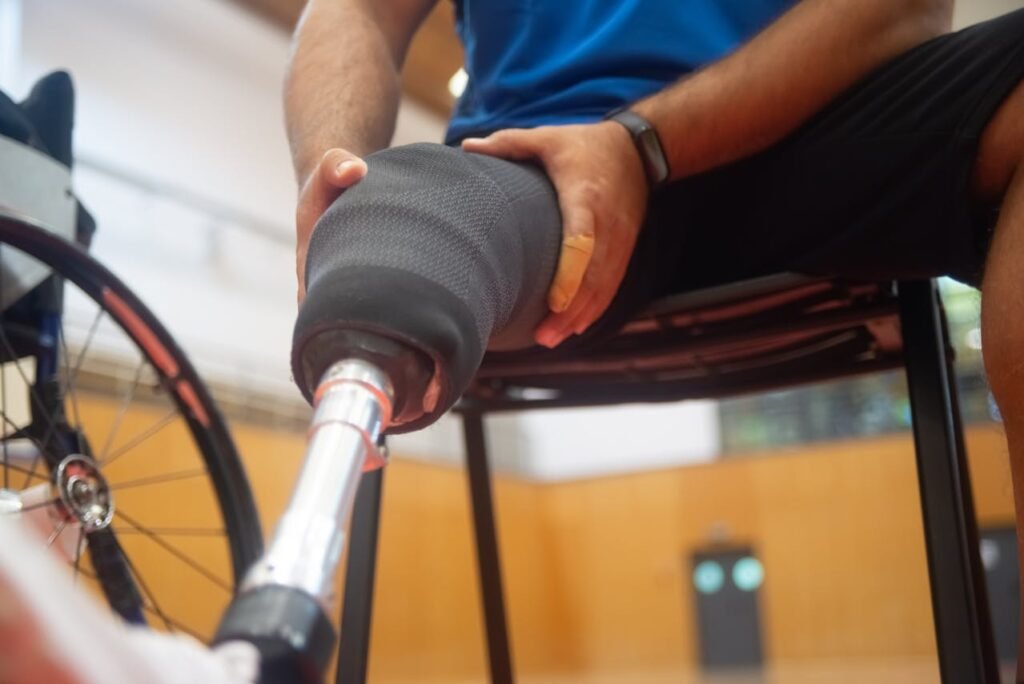
The upper part of your shoe—the section that covers the top of your foot—greatly affects your comfort. Breathable materials like mesh or soft leather keep your feet cool and reduce sweating, which is especially helpful for seniors who wear prosthetics for long hours.
Synthetic uppers are durable and often lighter, while leather molds naturally to your foot’s shape over time. Mesh, on the other hand, offers better ventilation and flexibility.
For prosthetic users, the goal is to keep the foot dry and comfortable without friction. Avoid stiff or poorly ventilated materials that trap moisture, as these can cause irritation and odor.
Insole Materials and Cushioning
A good insole absorbs shock and reduces pressure on your foot and joints. Memory foam and gel insoles are excellent choices for seniors—they adjust to your body weight and provide custom comfort.
If you use a prosthetic foot, ask your prosthetist whether you should use additional insoles or padding. Some prostheses already have built-in cushioning, and extra layers might alter alignment.
For best results, choose removable insoles. This allows easy cleaning and replacement when they wear out or absorb too much moisture.
Outsole Materials for Grip
Outsoles are the bottom part of the shoe that touches the ground. For seniors with prosthetics, the grip and flexibility of this part are crucial.
Rubber is one of the best outsole materials. It provides traction on both smooth and rough surfaces, prevents slipping, and lasts long.
Avoid plastic or hard leather soles—they don’t offer enough grip and can slide easily, especially on tiled or polished floors.
If you walk outdoors frequently, look for deep tread patterns that provide additional stability on uneven paths or during rainy conditions.
Lining and Stitching Quality
The inside of your shoe should feel smooth, with soft stitching and no hard edges. Rough seams can cause rubbing or blisters, especially where the prosthetic meets your natural skin.
A padded lining adds comfort while reducing pressure points. Moisture-wicking linings help keep your feet dry, which is essential for hygiene and comfort during long wear.
Before buying, always run your fingers inside the shoe. If you feel any sharp edges or seams, it’s not the right pair for you.
Maintaining Prosthetic-Friendly Footwear
Daily Cleaning Routine
Clean shoes aren’t just about looks—they’re about hygiene and safety. Dust and sweat can make soles slippery and reduce grip over time.
Each evening, wipe your shoes with a damp cloth to remove dirt. If they’re fabric or mesh, use a soft brush. Avoid soaking them in water—it weakens adhesives and stitching.
Remove insoles and let them air out overnight. This helps prevent moisture buildup and keeps odors away.
Checking for Wear and Tear
Shoes wear out faster than you might think. For prosthetic users, even minor wear can affect balance or alignment.
Check your soles weekly for uneven wear. If one side looks thinner, it may be time to replace the pair. Worn soles can cause you to tilt slightly, straining your joints and affecting your gait.
Also inspect the inner padding and stitching. Once you notice cracks or flattening inside the shoe, comfort and safety start to decline.
Proper Storage
Store shoes in a cool, dry place to prevent moisture and odor. Avoid keeping them near heat sources like radiators or sunlight, as this can make the material brittle.
If you have multiple pairs, alternate them daily. This gives each pair time to air out and helps extend their lifespan.
Using shoe trees or stuffing paper inside can help maintain shape, especially for leather shoes.
Replacing Insoles and Laces
Over time, insoles flatten and lose cushioning. Replacing them every few months keeps your comfort consistent and hygiene intact.
If your shoes use laces, check them often for fraying or tightness. Worn laces can loosen unexpectedly, increasing the risk of tripping.
Small replacements like these make a big difference in long-term performance and stability.
Keeping Feet Comfortable and Healthy
Daily Foot Care Routine
Healthy feet mean a more comfortable prosthetic experience. Wash your feet daily with mild soap and lukewarm water, then dry them completely—especially between your toes.
Apply moisturizer at night to prevent dryness, but avoid using it before putting on shoes or socks in the morning. Moisture inside footwear can increase friction.
Check your feet daily for redness, blisters, or swelling. These can be early signs that your shoes or prosthesis need adjustment.
Choosing the Right Socks
Socks play a huge role in comfort. For seniors, soft, breathable, and non-restrictive materials are best.
Cotton and wool blends wick away moisture, while seamless socks prevent friction and blisters. Avoid tight elastic bands at the top—they can restrict circulation.
If you wear a prosthesis on one side, choose socks that match the liner thickness and fit evenly to maintain balance.
Managing Swelling and Fatigue
It’s normal for legs or feet to swell slightly during the day. To manage this, elevate your legs for short periods and wear shoes with adjustable straps.
Compression socks can also help, but always check with your doctor before using them, especially if you have circulation concerns.
Fatigue often comes from tight shoes or heavy soles. If your feet feel sore by midday, your footwear may be too rigid or worn out.
Hygiene Tips for Freshness
Good hygiene prevents discomfort and infection. Change socks daily and let shoes dry completely before wearing them again.
If you notice persistent odor, sprinkle a little baking soda inside overnight or use foot powders made for seniors.
Avoid using perfumed sprays inside your shoes—they often mask smells without solving moisture buildup. Clean shoes are always the best deodorizer.
Seasonal Footwear Tips
Monsoon and Wet Conditions
Wet weather demands extra grip. Choose shoes with non-slip rubber soles and closed tops to keep water out.
Avoid open sandals or smooth-bottom shoes—they lose traction easily when wet. Waterproof walking shoes or boots are ideal during the rainy season.
After wearing wet shoes, dry them thoroughly before the next use. Stuff them with paper to absorb moisture, and never store them damp.
Summer Comfort
In summer, your feet need air. Choose lightweight, breathable shoes made from mesh or canvas.
Avoid dark colors—they absorb heat and make your feet sweat more. Instead, go for light shades that stay cool.
If you experience sweating inside your prosthesis, switch to moisture-wicking socks and liners for added comfort.
Winter Warmth
In colder months, warmth and insulation matter most. Opt for shoes with soft linings and slightly thicker socks.
However, avoid bulky shoes that restrict movement or add too much height to one side. Consistency in heel height is important to keep your prosthesis aligned.
If you walk on slippery winter surfaces, make sure your soles have deep traction patterns or consider removable anti-slip grips.
Safety and Confidence in Every Step
Preventing Slips and Falls
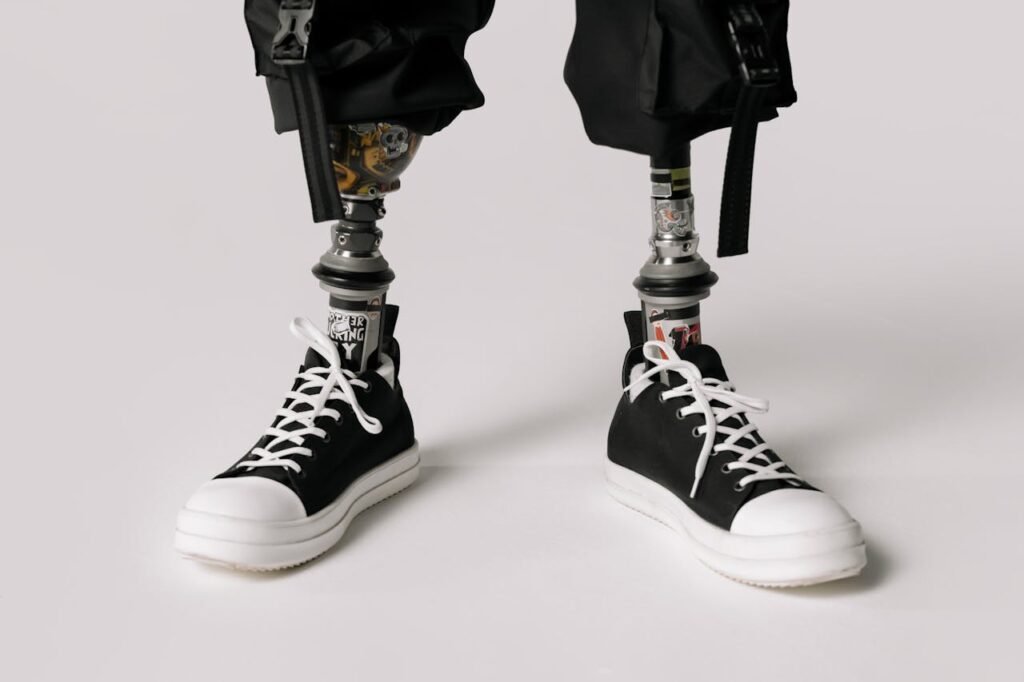
Falls are one of the biggest risks for seniors, especially when using prosthetics. The right footwear helps prevent them.
Always prioritize shoes with textured soles and good traction. If your home has smooth floors, use non-slip mats or rugs for extra safety.
Practicing good posture and balance exercises also helps strengthen stability over time.
Regular Check-Ins with Your Prosthetist
Your prosthetist can evaluate how your footwear interacts with your prosthesis. Even small issues in heel height or sole stiffness can change your gait.
Schedule a review every few months or whenever you change your shoes. Your prosthetist can make quick adjustments that improve comfort instantly.
This teamwork ensures that your shoes and prosthesis always work together in harmony.
Confidence Comes from Comfort
When your shoes fit right and feel secure, you move naturally. Each step becomes smoother, lighter, and more confident.
Confidence doesn’t just come from physical balance—it comes from trust. Trust in your prosthesis, your footwear, and your ability to move safely wherever life takes you.
Walking comfortably again isn’t a dream. It’s the result of the right care, the right fit, and the right guidance.
The RoboBionics Approach to Safe Mobility
Our Focus on Comfort and Design
At RoboBionics, we believe that technology should move with your body—not against it. Our prosthetics are designed to adapt to your lifestyle, ensuring every step feels natural and secure.
We understand that footwear plays a major role in how you experience comfort. That’s why our specialists work with seniors to guide them on the best footwear choices for stability, alignment, and confidence.
Supporting Independence for Seniors
Our goal is to make independence simple. From bionic hands to advanced lower-limb prosthetics, our innovations are built to restore mobility without compromising comfort.
We also help seniors understand daily care—like how to select safe shoes, maintain liners, and prevent skin issues—so they can live freely and move with ease.
The First Step Toward Confidence
The right prosthesis paired with the right footwear can transform your day. It means fewer slips, better posture, and renewed freedom to go wherever you want.
At RoboBionics, we’re here to support you every step of the way. Whether you’re exploring advanced prosthetic technology or learning how to make each step more comfortable, we’re with you.
If you’d like to experience how a well-fitted prosthesis and safe footwear can bring comfort back into your life, you can schedule a personalized demo at robobionics.in/bookdemo.



